Gaia Observes a Cosmic Clock Inside a Large Planetary Nebula
The ESA Gaia mission website recently published an image of a planetary nebula, supplemented with three years of data gathered by the satellite. Inside this object, twinkles a blue dot with a very regular pulse of light. This is the mother binary star system of the planetary nebula. Truly a hefty cosmic clock in our galaxy!

Planetary nebula Heckathorn-Fesen-Gull 1 observed from Earth. Gaia observed the blue star V664 Cas at its center over a hundred times in 2014-2017. This close binary shows very regular brightness changes (top left inset panel) due to a bright surface spot. The bottom right panel shows bright lines of hydrogen gas in the Gaia spectrum, classifying it as an ‘emission’ line star. Image credits: Peter Goodhew – Inset graphics: ESA/Gaia/DPAC.
This is an image of planetary nebula Heckathorn-Fesen-Gull 1 (also HFG1) observed from Earth and taken by amateur astronomer Peter Goodhew. Planetary nebulae are not planets but gaseous layers ejected from a star of 1 to 10 solar masses in the final stages of its life. They are among the most beautiful objects in the Universe. HFG1 is one of the largest planetary nebula currently known.
Some planetary nebulae, such as HFG1, envelop a multiple star system. The blue dot at the center of HFG1 is the binary system V664 Cassiopeiae (V664 Cas). V664 Cas was observed over one hundred times by the Gaia satellite between 2014 and 2017.
The inset images show Gaia data of V664 Cas related to its luminosity variation (top left) and to its spectra (bottom right). The red curves in the top left panel show the periodic brightness changes of the binary system. A small but very hot dwarf star irradiates part of a larger and cooler star (like our Sun or a red giant) heating a bright area of its surface. Gaia observes how the hot spot’s projected size and apparent brightness varies while both stars orbit each other. A very accurate orbital period of 13 hours, 57 minutes and 35 seconds has been determined for V664 Cas with the Gaia data. These very regular brightness changes truly represent an accurate cosmic clock in our galaxy.
The bottom right panel shows bright lines of ionized hydrogen gas, marked with H-alpha and H-beta, which are observed by Gaia. Astronomers use these and other emission lines from other elements for measuring the chemical composition, temperature and density of the nebular gas.
Gaia has also measured other stellar parameters related to HFG1 and V664 Cas. With the combination of various parameters astronomers obtain new insights in the physics of planetary nebulae and the stellar systems that produce them.
More information about the image can be found on the ESA Gaia Mission webpage: https://www.cosmos.esa.int/web/gaia/iow_20231031.
About Gaia and the Royal Observatory of Belgium’s contribution to this mission
The Gaia satellite, launched by ESA, has been charting the whole sky since 2014, and its map includes stars that are a million times fainter than can be seen with the naked eye. The data gathered by Gaia are analyzed within the Data Analysis and Processing Consortium (DPAC), and its data products have been published in three major releases and two minor ones, the most recent one on 10 October 2023. Two more releases are planned in the next decade. A scientist team of the Royal Observatory of Belgium, consisted of Ronny Blomme, Alex Lobel, Yves Frémat and Thierry Pauwels, is involved in the DPAC of Gaia.

